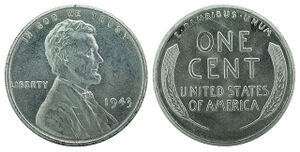1943 steel cent (nonfiction): Difference between revisions
No edit summary |
|||
| (One intermediate revision by the same user not shown) | |||
| Line 1: | Line 1: | ||
'''1943 steel cent''' refers to a U.S. one-cent coin that was struck in steel due to wartime shortages of copper. The Philadelphia, Denver, and San Francisco mints each produced these 1943 Lincoln cents. The unique composition of the coin (low-grade steel coated with zinc, instead of the usual bronze composition) has led to various nicknames, such as wartime cent, steel war penny, and steelie. The 1943 steel cent features the same Victor David Brenner design for the Lincoln cent which had been in use since 1909. | [[File:1943 Lincoln Cent (wheat, zinc-coated steel).jpg|thumb|1943-1C-Lincoln Cent (wheat, zinc-coated steel). JN2015-6846-47.]]'''1943 steel cent''' refers to a U.S. one-cent coin that was struck in steel due to wartime shortages of copper. The Philadelphia, Denver, and San Francisco mints each produced these 1943 Lincoln cents. The unique composition of the coin (low-grade steel coated with zinc, instead of the usual bronze composition) has led to various nicknames, such as wartime cent, steel war penny, and steelie. The 1943 steel cent features the same Victor David Brenner design for the Lincoln cent which had been in use since 1909. | ||
Due to wartime needs of copper for use in ammunition and other military equipment during World War II, the United States Mint researched various ways to limit dependence and meet conservation goals on copper usage. After trying out several substitutes (ranging from other metals to plastics) to replace the then-standard bronze alloy, the one-cent coin was minted in zinc-coated steel. This alloy caused the new coins to be magnetic and 13% lighter. They were struck at all three mints: Philadelphia, Denver, and San Francisco. As with the bronze cents, coins from the latter two sites have respectively "D" and "S" mintmarks below the date. | Due to wartime needs of copper for use in ammunition and other military equipment during World War II, the United States Mint researched various ways to limit dependence and meet conservation goals on copper usage. After trying out several substitutes (ranging from other metals to plastics) to replace the then-standard bronze alloy, the one-cent coin was minted in zinc-coated steel. This alloy caused the new coins to be magnetic and 13% lighter. They were struck at all three mints: Philadelphia, Denver, and San Francisco. As with the bronze cents, coins from the latter two sites have respectively "D" and "S" mintmarks below the date. | ||
| Line 20: | Line 20: | ||
* [[1943 copper cent (nonfiction)]] | * [[1943 copper cent (nonfiction)]] | ||
External links | == External links == | ||
* [https://en.wikipedia.org/wiki/1943_steel_cent 1943 steel cent] @ Wikipedia | * [https://en.wikipedia.org/wiki/1943_steel_cent 1943 steel cent] @ Wikipedia | ||
[[Category:Nonfiction (nonfiction)]] | [[Category:Nonfiction (nonfiction)]] | ||
[[Category:Coins (nonfiction)]] | |||
Latest revision as of 19:38, 27 September 2023
1943 steel cent refers to a U.S. one-cent coin that was struck in steel due to wartime shortages of copper. The Philadelphia, Denver, and San Francisco mints each produced these 1943 Lincoln cents. The unique composition of the coin (low-grade steel coated with zinc, instead of the usual bronze composition) has led to various nicknames, such as wartime cent, steel war penny, and steelie. The 1943 steel cent features the same Victor David Brenner design for the Lincoln cent which had been in use since 1909.
Due to wartime needs of copper for use in ammunition and other military equipment during World War II, the United States Mint researched various ways to limit dependence and meet conservation goals on copper usage. After trying out several substitutes (ranging from other metals to plastics) to replace the then-standard bronze alloy, the one-cent coin was minted in zinc-coated steel. This alloy caused the new coins to be magnetic and 13% lighter. They were struck at all three mints: Philadelphia, Denver, and San Francisco. As with the bronze cents, coins from the latter two sites have respectively "D" and "S" mintmarks below the date.
However, problems began to arise from the mintage. Freshly minted, they were often mistaken for dimes. Magnets in vending machines (which took copper cents) placed to pick up steel slugs also picked up the legitimate steel cents. Because the galvanization process didn't cover the edges of the coins, sweat would quickly rust the metal. After public outcry, the Mint developed a process whereby salvaged brass shell casings were augmented with pure copper to produce an alloy close to the 1941–42 composition. This was used for 1944–46-dated cents, after which the prewar composition was resumed. Although they continued to circulate into the 1960s, the mint collected large numbers of the 1943 cents and destroyed them.
The steel cent is the only regular-issue United States coin that can be picked up with a magnet. The steel cent was also the only coin issued by the United States for circulation that does not contain any copper. (Even U.S. gold coins at various times contained from slightly over 2% copper to an eventual standard 10% copper).
In the News
Fiction cross-reference
Nonfiction cross-reference
External links
- 1943 steel cent @ Wikipedia
